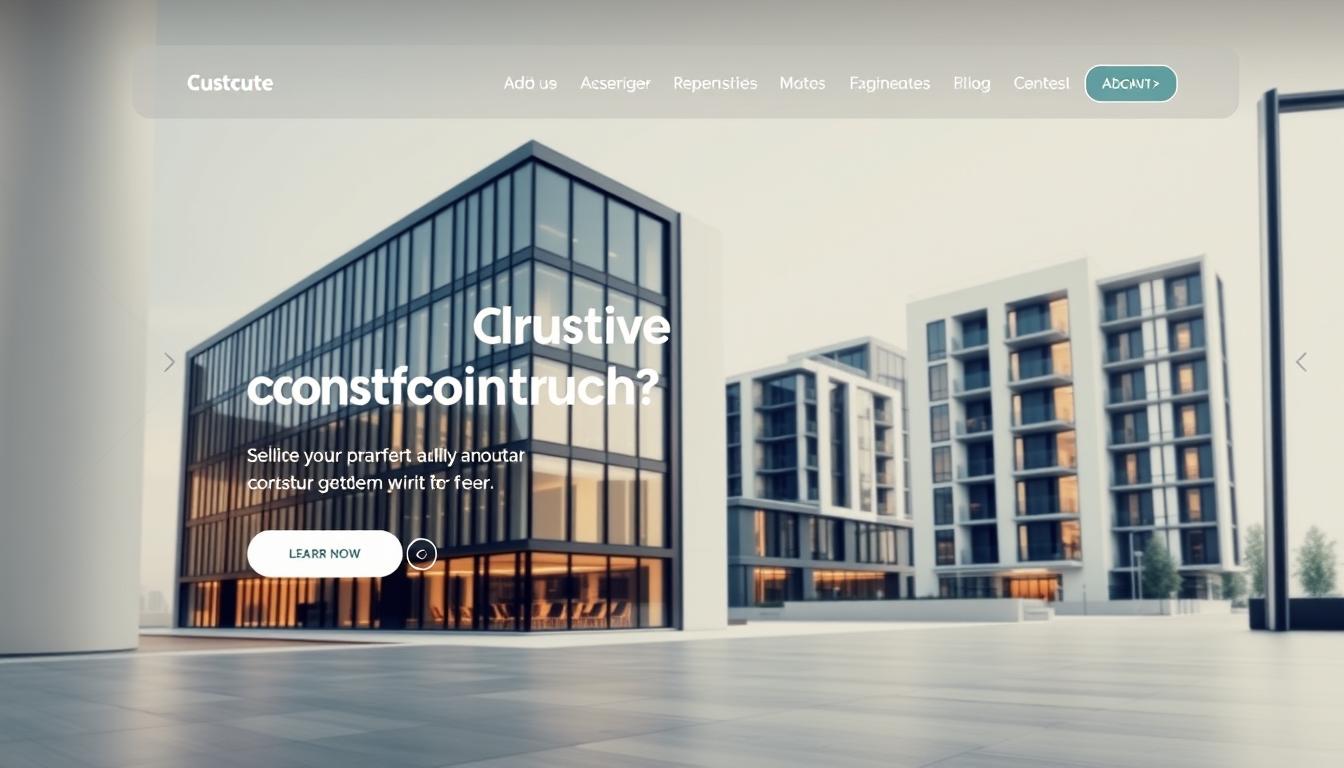Twenty years ago, a basic online presence with text and low-quality images might have worked for contractors. Today’s clients expect polished digital experiences that reflect a company’s expertise before they ever pick up the phone. Your digital front door matters more than ever in an industry where trust drives decisions.
Gone are the days of static online brochures. Modern businesses need dynamic platforms that educate visitors, showcase past projects, and simplify lead generation. Why does this shift matter? Homeowners and commercial clients increasingly research contractors online, often comparing multiple options before requesting quotes.
A well-crafted site does more than list services—it tells your story through visuals, client testimonials, and clear calls to action. Features like mobile optimization and fast load times aren’t just technical details; they signal professionalism in a crowded market.
Key Takeaways
- Digital standards have shifted from basic sites to interactive platforms that build credibility
- Over 75% of clients research multiple contractors online before contacting anyone
- Mobile-friendly designs and fast loading speeds directly impact user trust
- Visual portfolios and case studies help clients envision working with your team
- Strategic placement of contact forms can increase lead conversion by 30% or more
The following analysis of industry-leading designs will reveal practical strategies to elevate your online presence. You’ll discover how top firms balance aesthetics with functionality while maintaining focus on what converts visitors into clients.
Introduction to the Latest Construction Website Trends
In an era where first impressions are digital, the bar for professional online presence has risen sharply. Clients now expect immersive experiences that showcase expertise before scheduling consultations. This shift has transformed static pages into interactive hubs, blending visual storytelling with practical tools for decision-making.
| Feature | Traditional Sites | Current Standards |
|---|---|---|
| Navigation | Basic menus | Intuitive user paths |
| Content Delivery | Text-heavy pages | Video walkthroughs & 3D models |
| Lead Generation | Single contact form | Contextual chat widgets |
One industry leader notes: “Sites that guide visitors from curiosity to action see 50% more quote requests.” This philosophy drives today’s designs, where every click serves a strategic purpose.
Simple Web Solutions helps firms implement these advancements through:
- Mobile-optimized layouts that adapt to any device
- Dynamic project galleries with before/after sliders
- Integrated cost calculators for instant estimates
These innovations don’t just impress clients—they actively position businesses as forward-thinking partners. The next sections explore how specific design choices translate to measurable results.
Emerging Design Elements for Modern Construction Websites
The way clients evaluate service providers has fundamentally changed. Over 59% now research potential partners through smartphones first. This shift demands layouts that adapt instantly while maintaining visual impact.
Mobile-First Design and Responsive Layout
Simple Web Solutions prioritizes fluid grids that rearrange content based on screen size. Buttons expand for thumb-friendly navigation. Font sizes adjust automatically to prevent zooming. These features keep visitors engaged 40% longer compared to non-responsive designs.
Key technical considerations include:
- Compressed images that load in under 2 seconds on 4G networks
- Touch-optimized menus with clear hierarchy
- Persistent contact buttons that follow users as they scroll
High-Quality Imagery and Rotating Headers
First impressions hinge on visuals. Rotating headers (3-5 images max) showcase completed projects without overwhelming viewers. Professional shots of worksites tell stories better than stock photos. “Clients need to envision their project’s success immediately,” notes a Simple Web Solutions designer.
Best practices balance aesthetics with performance:
- Use WebP format for 30% smaller file sizes
- Implement lazy loading for below-the-fold content
- Add brief video snippets (under 15 seconds) to highlight craftsmanship
These strategies create immersive experiences that convert casual browsers into qualified leads. The next section explores how to amplify visibility through targeted optimization techniques.
SEO Optimization Strategies for Construction Companies
In today’s digital race, construction firms can’t afford to be invisible online. Simple Web Solutions crafts tailored campaigns that align with how clients search for services like roofing, remodeling, or commercial builds. Mobile optimization isn’t optional—Google now indexes smartphone-friendly pages first, making responsive design critical for visibility.
Effective strategies start with localized keyword research. Targeting phrases like “emergency roof repair [City Name]” or “commercial contractor near me” helps businesses appear in hyper-relevant searches. Title tags and meta descriptions should clearly state service areas while incorporating geographic modifiers.
Technical improvements drive measurable results. Compressing images reduces load times by up to 50%, while structured data markup helps search engines understand project types and service locations. A well-optimized Google Business Profile combined with local directory listings can triple map pack appearances.
Content marketing establishes authority. Publishing case studies about completed projects or guides on permit processes answers common client questions. These resources attract organic traffic while positioning firms as trusted advisors. One Simple Web Solutions client saw 120% more quote requests after adding neighborhood-specific service pages.
Regular audits identify hidden opportunities. Monitoring backlinks from industry associations or updating outdated content keeps sites competitive. Combining these tactics creates a sustainable pipeline of qualified leads ready to hire.
The Role of Schema Markup and Fast-Loading Pages
Behind every successful online presence lies invisible architecture that search engines and users rely on. Schema markup acts like a translator, helping algorithms understand your services and location. Fast-loading pages keep visitors engaged instead of frustrated.
Improving Search Rankings and User Experience
Structured data tags like LocalBusiness and Service create rich search results. These snippets display your phone number, reviews, and service areas directly in Google. One study found pages with schema markup rank 4 positions higher on average.
Speed impacts decisions more than you might think. Sites loading in 2 seconds see 9% higher conversion rates than those taking 5 seconds. Mobile users abandon pages that lag—53% leave if loading exceeds 3 seconds.
Simple Web Solutions uses proven methods to optimize performance:
- Compressing images without quality loss
- Minifying CSS/JavaScript files
- Enabling browser caching for repeat visitors
Combining technical SEO with speed upgrades creates a seamless experience. Customers find your business faster, while your site earns trust through reliability. These improvements work together to turn casual clicks into concrete leads.
Showcasing an Engaging Portfolio of Past Projects
A well-curated portfolio does more than display past work—it answers critical client questions before they ask. Portfolios serve as visual resumes that prove capabilities through completed projects rather than claims. Clients want to see how challenges were solved, timelines met, and quality maintained.
Organize projects by type or scale with intuitive filters. Residential remodels could sit beside commercial builds, each tagged with square footage or budget ranges. This helps visitors quickly find relatable examples. Simple Web Solutions often implements comparison sliders showing before-and-after transformations to highlight craftsmanship.
Professional photography matters. Grainy smartphone shots undermine credibility, while high-resolution images capture textures and lighting. Pair visuals with concise details: project goals, unexpected obstacles overcome, and client feedback. One contractor increased inquiries by 65% after adding 360-degree views of finished spaces.
Select projects that mirror your ideal client’s aspirations. A kitchen remodel firm might showcase mid-range and luxury upgrades to appeal to different budgets. Every entry should reinforce expertise while telling a story of partnership and precision.
Leveraging Customer Testimonials and 5-Star Reviews
In a world where trust is built through digital interactions, authentic client voices become your strongest sales tool. BrightLocal’s 2025 survey reveals 46% of buyers trust testimonials as much as personal recommendations. This shift makes strategic review management essential for firms aiming to stand out.
Placement matters. Integrate quotes into service pages where prospects evaluate options. Feature video testimonials on portfolio sections to humanize past projects. A dedicated review page allows deeper exploration of client experiences without distracting from core offerings.
Automating Credibility Building
Simple Web Solutions streamlines feedback collection with automated tools that prompt clients post-project. These systems simplify leaving reviews while directing concerns to private channels. One user noted: “Our positive feedback rate tripled once we made sharing effortless.”
| Approach | Traditional Method | Modern Solution |
|---|---|---|
| Review Collection | Manual follow-ups | Automated SMS/email sequences |
| Response Time | Days to address issues | Real-time alerts for urgent feedback |
| Display Methods | Static text boxes | Interactive widgets with filtering |
Negative reviews? Handle them professionally. Public responses showing problem-solving build more trust than perfection. Train teams to request specific praise—like quality craftsmanship or adherence to timelines—to create compelling narratives.
Encourage clients to share how your service solved unique challenges. Detailed stories resonate deeper than generic five-star ratings, helping prospects visualize successful partnerships.
Clear Pricing and Real Support Advantages
Clients today expect clarity before committing to partnerships. Service providers that hide costs or use vague estimates risk losing 43% of potential leads immediately. Simple Web Solutions helps businesses build trust through transparent pricing models that balance detail with flexibility.
Effective strategies avoid rigid price lists while educating clients. For example:
- Range-based estimates for common projects (e.g., kitchen remodels: $25k–$40k)
- Interactive calculators for square footage or material costs
- Side-by-side comparisons showing value-added services
One company using this approach saw 28% more qualified leads within three months. “Clients appreciate knowing what to expect before scheduling consultations,” notes a Simple Web Solutions project manager.
Real support completes the equation. Businesses using in-house teams resolve issues 65% faster than those relying on third-party services. Direct communication channels—like dedicated phone lines or live chat—prevent misunderstandings and build lasting relationships.
Transparency isn’t just ethical—it’s strategic. Companies that outline costs upfront reduce friction in the decision process, while reliable support turns first-time clients into repeat partners.
Highlighting Essential Website Sections for Construction Businesses
Every click on a professional site should answer questions before visitors ask them. Strategic page organization builds trust while guiding prospects toward meaningful actions. Simple Web Solutions structures digital platforms around four core sections that meet client expectations and search engine requirements.
About Us: Your Digital Handshake
This section replaces formal introductions with relatable storytelling. Share founding stories, team credentials, and safety certifications. Photos of staff at work sites add authenticity. One remodeler increased consultation requests by 40% after adding project timeline infographics to their About page.
Services: Clarity Over Complexity
Break offerings into digestible categories with visual filters. Use icons to differentiate residential from commercial work. Include brief explanations of processes rather than technical jargon. A roofing company saw 22% more quote requests by adding “See Typical Costs” buttons beside each service description.
| Page Type | Traditional Approach | Optimized Approach |
|---|---|---|
| About Us | Generic mission statement | Team bios with project photos |
| Services | Bulleted service lists | Interactive service filters |
| Contact | Single email form | Live chat + SMS options |
Portfolio: Proof Through Projects
Curate 8-12 recent jobs that represent your best work. Tag images with client goals and challenges overcome. Contractors using 360-degree virtual tours report 35% longer engagement times compared to static galleries.
Contact: Removing Friction
Simplify communication with multiple options: click-to-call buttons, service-specific forms, and office location widgets. One builder reduced missed leads by 60% after adding an “Upload Blueprints” feature to their contact section. As a Simple Web Solutions developer notes: “Every barrier removed converts more window-shoppers into clients.”
Construction Website Examples: A Deep Dive into Best Practices
Leading firms reveal how strategic digital platforms drive engagement and project wins. By studying industry leaders, businesses discover proven methods to balance visual appeal with functional clarity. Three organizations stand out for their ability to convert casual browsers into committed partners through intentional design choices.
Insights from Top Industry Leaders
Kiewit Corporation’s homepage uses rotating project images with overlay text showing scale and expertise. Revenue figures and industry rankings appear subtly, building instant credibility. This approach answers visitor questions before they ask, reducing decision-making friction.
Bechtel excels at guiding users with intuitive navigation. Global contact details and service links appear prominently without clutter. Their two-click rule ensures visitors reach critical information fast. Turner Construction’s minimalist color scheme focuses attention on project showcases, while dedicated service pages cater to specific client needs.
These company websites share common trust-building elements: clear value propositions, evidence of reliability, and effortless pathways to connect. Simple Web Solutions adapts these strategies for smaller firms, emphasizing mobile-friendly layouts and localized content. The result? Digital platforms that feel both professional and approachable.
Every design decision should serve a purpose. Whether highlighting team expertise or simplifying quote requests, your online presence must mirror the precision clients expect from your physical work. Study what works, then make it uniquely yours.
FAQ
How can a construction business make its site stand out from competitors?
Focus on unique value propositions like specialized certifications, eco-friendly practices, or client-centric workflows. Use video case studies, interactive project timelines, and localized content to highlight expertise in your region.
What’s the most overlooked element in construction website design?
Many firms underutilize service area pages. Dedicated pages for specific cities or neighborhoods improve local SEO and help clients instantly see if you operate in their area. Pair these with geo-targeted testimonials for maximum impact.
Are chatbots effective for lead generation in this industry?
Yes—when programmed to answer common queries like “Do you handle commercial permits?” or “What’s your roofing warranty?”. Chatbots reduce response time and qualify leads 24/7, but ensure they transfer complex questions to human agents seamlessly.
How often should project portfolios be updated?
Refresh portfolios quarterly, adding at least 2-3 new projects with before/after visuals and brief narratives. Archive older work to a secondary gallery to keep the main showcase current without losing historical credibility.
Should pricing be displayed openly on construction sites?
A> While exact quotes require customization, provide transparent starting ranges (e.g., “Kitchen remodels from k+”). This filters out mismatched budgets early and positions your firm as upfront—a key trust signal for homeowners.
What’s the fastest way to improve page load speed?
Compress images using tools like ShortPixel, enable browser caching, and eliminate unnecessary plugins. For construction sites, prioritize optimizing project gallery grids and header images, which are often the heaviest elements.
How can small firms compete with larger brands online?
Emphasize hyper-local SEO and niche specialties (e.g., “historic home restoration” or “ADA-compliant builds”). Client stories highlighting personalized service often resonate more than corporate-scale claims.





0 Comments